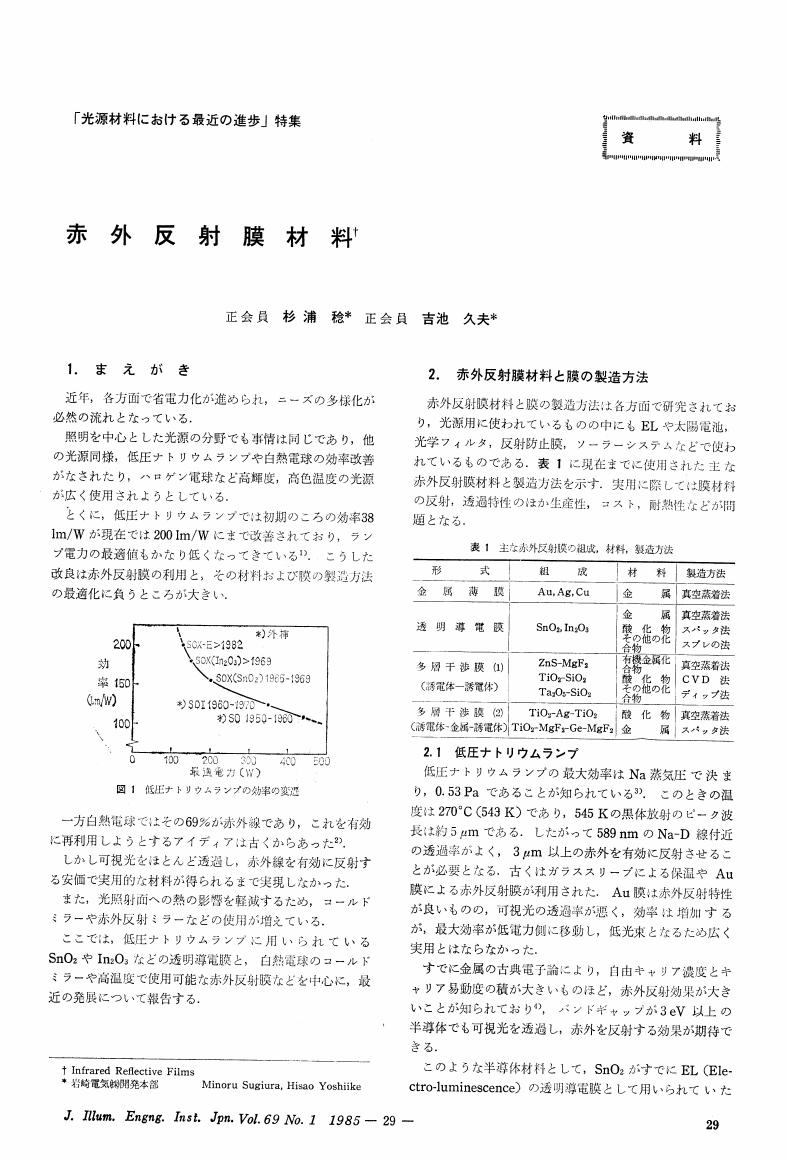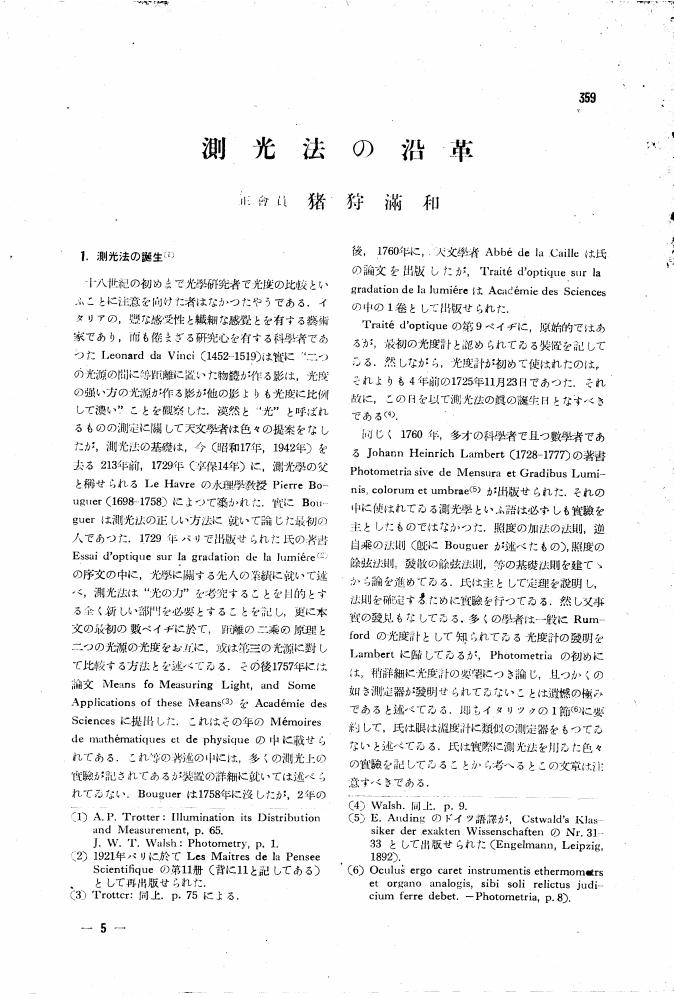1 0 0 0 OA 日本の地震の予知問題
- 著者
- 茂木 清夫
- 出版者
- 一般社団法人 照明学会
- 雑誌
- 照明学会誌 (ISSN:00192341)
- 巻号頁・発行日
- vol.81, no.Appendix, pp.40, 1997-03-28 (Released:2011-07-19)
日本は世界有数の地震国であり, これまでたびたび大震災を経験してきた. 先進国の中で国全体が活発な地震帯の中にある国は日本だけである. 従って, いかにして地震災害を軽減するかという問題は, とりわけ我が国において重要な問題であり, その対策の一つとして, 地震予知計画が30年前にナショナルプロジェクトとしてスタートし, 今日に至っている.その間, 国内・国外において地震予知の可能性について, ある時には極端な楽観論が台頭し, ある時には悲観論が主張され, 今日なお地震予知の可能性についての対立した議論が続いている. 極端な悲観論も楽観論も適当でない.一昨年の阪神大震災はここ50年の間では際立って大きい災害をもたらした. この地震は, 予知されずに突発的に起こったが, 地震発生後収集された前兆現象をまとめて見ても, 微弱であり, 予知が困難なケースであった.最後に, 1978年に制定された大規模地震対策特別措置法 (大震法) によって, 予知できることを前提とした東海地震対策が進められているが, その重大な問題点を指摘し, その早急な再検討が必要である.
1 0 0 0 さいたまアリーナ (仮称)
- 著者
- 亀井 忠夫 廣川 純一 星野 修一郎
- 出版者
- 一般社団法人 照明学会
- 雑誌
- 照明学会雑誌 (ISSN:00192341)
- 巻号頁・発行日
- vol.81, no.10, pp.920-923, 1997
1 0 0 0 倉敷アイビースクエアの照明
- 著者
- 寺地 弘
- 出版者
- 一般社団法人 照明学会
- 雑誌
- 照明学会雑誌 (ISSN:00192341)
- 巻号頁・発行日
- vol.61, no.3, pp.141-145, 1977
1 0 0 0 OA 国鉄における鉄道施設照明基準
- 著者
- 市川 忠
- 出版者
- 一般社団法人 照明学会
- 雑誌
- 照明学会雑誌 (ISSN:00192341)
- 巻号頁・発行日
- vol.51, no.11, pp.638-647, 1967-11-25 (Released:2011-07-19)
1 0 0 0 OA エーゲ海スケッチ紀行 (3) ペロポネソス周辺の環境
- 著者
- 小泉 実
- 出版者
- 一般社団法人 照明学会
- 雑誌
- 照明学会誌 (ISSN:00192341)
- 巻号頁・発行日
- vol.81, no.6, pp.518-519, 1997-06-01 (Released:2011-07-19)
- 著者
- 勝柴 次朗
- 出版者
- 一般社団法人 照明学会
- 雑誌
- 照明学会誌 (ISSN:00192341)
- 巻号頁・発行日
- vol.95, no.6, 2011
- 著者
- 上野 隆士
- 出版者
- 一般社団法人 照明学会
- 雑誌
- 照明学会雑誌 (ISSN:00192341)
- 巻号頁・発行日
- vol.77, no.11, pp.706-708, 1993
1 0 0 0 OA どうなる手術用無影灯
- 著者
- 関 紀夫
- 出版者
- 一般社団法人 照明学会
- 雑誌
- 照明学会誌 (ISSN:00192341)
- 巻号頁・発行日
- vol.81, no.12, pp.1072-1077, 1997-12-01 (Released:2011-07-19)
- 参考文献数
- 3
1 0 0 0 OA 赤外反射膜材料
- 著者
- 杉浦 稔 吉池 久夫
- 出版者
- 一般社団法人 照明学会
- 雑誌
- 照明学会誌 (ISSN:00192341)
- 巻号頁・発行日
- vol.69, no.1, pp.29-32, 1985-01-01 (Released:2011-07-19)
- 参考文献数
- 19
1 0 0 0 イネ光害回避型照明の視認性評価
- 著者
- 原田 陽子 山本 晴彦 岩谷 潔 金子 奈々恵
- 出版者
- 一般社団法人 照明学会
- 雑誌
- 照明学会誌 (ISSN:00192341)
- 巻号頁・発行日
- vol.97, no.8, pp.436-441, 2013-08-01
- 参考文献数
- 12
In agriculture, particularly wet rice cultivation, light pollution caused by exterior illumination at night interferes with dark periods and results in delayed flowering (heading). However, we found that by selecting the wavelength of light sources to which rice is exposed and controlling the luminescence, it is possible to bring the time of heading closer to that of a control plot (total darkness). In this study, visibility of artificial illumination using mixed LED (blue, green, yellow-green) was evaluated by comparing it with green LED and white LED illumination. We evaluated five items in this experiment: pedestrian behavior, facial recognition, color recognition, peripheral visual field, and impression. We found that the evaluation for ‘color recognition’ and ‘impression’ were lower for mixed LED than for white LED illumination. Therefore, it is suggested that mixed LED illumination needs to improve in these items.
- 著者
- 真野 克彦 福田 耕三 向阪 信一 洞口 公俊 岡田 俊也 染郷 正孝
- 出版者
- 一般社団法人 照明学会
- 雑誌
- 照明学会雑誌 (ISSN:00192341)
- 巻号頁・発行日
- vol.80, pp.316-317, 1996
1 0 0 0 植物の照明影響
- 著者
- 蓑原 善和
- 出版者
- 一般社団法人 照明学会
- 雑誌
- 照明学会誌 (ISSN:00192341)
- 巻号頁・発行日
- vol.80, no.10, pp.741-745, 1996-10-01
- 参考文献数
- 11
- 被引用文献数
- 3
- 著者
- 近田 玲子 平松 那須加
- 出版者
- 一般社団法人 照明学会
- 雑誌
- 照明学会誌 (ISSN:00192341)
- 巻号頁・発行日
- vol.99, no.3, pp.171-174, 2015
A hotel founded in 1880s in a famous hot-spring area underwent a renovation of some guest rooms, corridors, big baths, and exterior after the Great East Japan Earthquake. Our tasks included: to build a comprehensive lighting design that makes the hotel unique and competitive; to design an extraordinary atmosphere in the rooms and stairs; to create gorgeous night view. Our lighting design concept was "The allure of Japan" All interior light sources are high color-rendering LEDs. The hotel's main feature is the beautiful waterfall and the garden stage view from the lobby and guest rooms. We created dramatic scenery throughout the garden. Preset one week lighting control system enabled easy operation and energy saving.
- 著者
- 河瀬 正毅
- 出版者
- 一般社団法人 照明学会
- 雑誌
- 照明学会誌 (ISSN:00192341)
- 巻号頁・発行日
- vol.97, no.1, pp.20-24, 2013
The 2011 winter illumination event of this garden park is themed on the four seasons of Japan. Wishing recovery from The Tohoku Earthquake, we created the landscapes surrounding the famous cherry tree in the region, using lights.
1 0 0 0 感覚刺激受け入れ範囲と刺激感受性の関係
- 著者
- 佐藤 愛子
- 出版者
- 一般社団法人 照明学会
- 雑誌
- 照明学会雑誌 (ISSN:00192341)
- 巻号頁・発行日
- vol.66, no.10, pp.490-494, 1982
In order to ask the subjects to answer their preference among environmental stimuli, and to estimate the extent of their own sensitiveness to intense or weak sensory stimuli, the two checklists were compiled. Using these lists, the two researches conducted.<BR>Research 1: By the Varimax method of the factor analysis, the 8 factors were obtained from the 36 items list with 100 male medical students. The following labeles were given to each of these 8 factors; A) General sensitivity, B) Temporal sensitivity, C) Orientation to the weak stimuli (the 2 factors were contained in this label), D) Orientation to the intense stimuli (the 2 factors were contained in this label), E) Activation level, and F) Abnormal temporal sensitivity. The label C) means the weakness in tolerance for intense stimuli, and the D) meansto to lerate intense stimuli.<BR>Research 2: The 6 factors were obtaind from the 58 items list with 229 male engineering students. The 5 factors of the 6s were named the same as to each of the 5 labeles in the research 1 (A to E). The other one was labeled G) sensorymotor reactivity. There is no abnormal sensitivity F).<BR>Discussion: The 4 properties, labeled A to D, were the sensory properties common to large samples of subjects. The other three were the depending properties on the individual differences in subjects. Since no factor correlations were in all factor combinations statistically, the common properties were inter independently. Thus we analogize that is not always necessary for the non-sensitive subjects to like the intense sensory stimuli, and not always necessary for the sensitive subjects to prefer the weak stimuli in environments.
1 0 0 0 赤外反射膜材料
- 著者
- 杉浦 稔 吉池 久夫
- 出版者
- 一般社団法人 照明学会
- 雑誌
- 照明学会雑誌 (ISSN:00192341)
- 巻号頁・発行日
- vol.69, no.1, pp.29-32, 1985
1 0 0 0 どうなる手術用無影灯
- 著者
- 関 紀夫
- 出版者
- 一般社団法人 照明学会
- 雑誌
- 照明学会雑誌 (ISSN:00192341)
- 巻号頁・発行日
- vol.81, no.12, pp.1072-1077, 1997
1 0 0 0 OA 測光 (其1)(8月)
1 0 0 0 OA 焦電形光検出器
- 著者
- 中川 靖夫
- 出版者
- 一般社団法人 照明学会
- 雑誌
- 照明学会誌 (ISSN:00192341)
- 巻号頁・発行日
- vol.67, no.1, pp.9-12, 1983-01-01 (Released:2011-07-19)
- 参考文献数
- 13
- 被引用文献数
- 1
1 0 0 0 OA 色光の誘目性について
- 著者
- 神作 博
- 出版者
- 一般社団法人 照明学会
- 雑誌
- 照明学会雑誌 (ISSN:00192341)
- 巻号頁・発行日
- vol.51, no.11, pp.684-690, 1967-11-25 (Released:2011-07-19)
- 参考文献数
- 27
- 被引用文献数
- 2
Attractiveness of colored lights was investigated through cinematograghic records of eye movements and verbal reports of ten observers obtained in the situation of paired presentation of colored lights.Three indices of attractiveness were used; the initial direction of eye movement, the dominant direction of eye movement, and verbal report.The main results are as follows:(1) Three indices of attractiveness were almost consistent with each other.(2) When the luminance was held constant (64 nt) and high purity colors were used, the order attractiveness of colored lights of five different hues was Red, Blue, Yellow, Green, and White (Illuminant A).(3) When the excitation purity was kept constant, the attractiveness of red light decreased as its luminance decreased.(4) When the luminance was kept constant, the attractiveness of red light decreased as the excitation purity decreased.(5) Five red lights having various luminances and purities were compared with the above mentioned high-purity colors whose luminance was constantly 64 nt. The obtained order of attractiveness was as follows: R (64 nt, 99%), B, Y, R (32 nt, 99%), R (64 nt, 84%), G, W, R (32 nt, 84%), and R (16nt, 99%).





